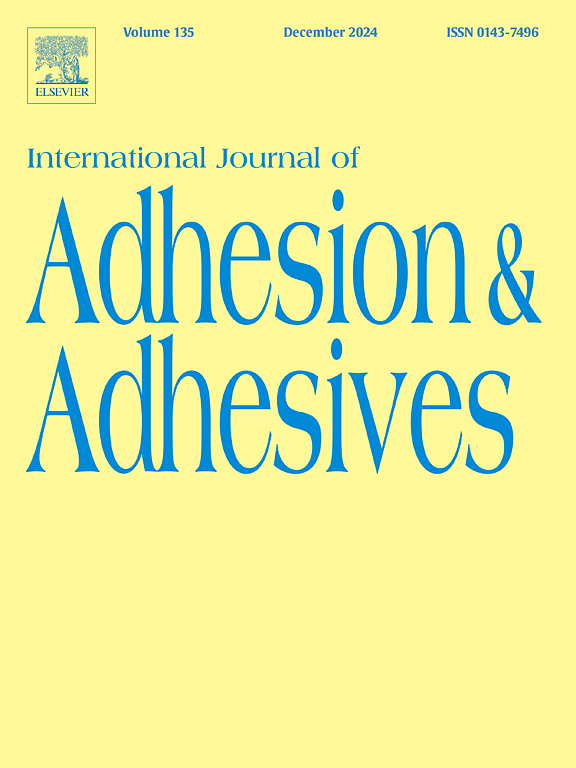Mechanical behaviour and durability of an epoxy adhesive for structural glass-to-steel connections in a ship
IF 3.5
3区 材料科学
Q2 ENGINEERING, CHEMICAL
International Journal of Adhesion and Adhesives
Pub Date : 2025-05-07
DOI:10.1016/j.ijadhadh.2025.104050
引用次数: 0
Abstract
The luxury yacht industry demands increased vessel transparency by enlarging glazed areas. Structurally integrating glass into yacht structures offers a solution to this. However, this requires a rigid and reliable connection between glass and metal components, which needs to be validated. Consequently, an epoxy adhesive is tested experimentally to evaluate its structural performance for such applications. First, tensile tests on dumbbell specimens are conducted at crosshead speeds of 0.1, 1, 10 and 50 mm/min and temperatures of −20, 23, 50 and 80 °C. Results show that both stiffness and strength increase with strain rate but decrease with increasing temperature, with significant loss at 80 °C. Second, shear tests on double-lap glass-to-steel specimens evaluate adhesion, using a bond thickness of 7 mm to accommodate geometric tolerances in a ship. This thickness is significantly larger than what is recommended by the manufacturer for maximum bond strength. Third, ageing tests are performed on dumbbell and double-lap specimens stored at 50 °C ± 1 °C and 94 ± 1 % relative humidity for six weeks. After ageing, tensile strength and stiffness of the epoxy reduced by 24 % and 51 %, respectively. While double-lap specimens exhibited reduced stiffness after ageing, the scatter on results could not be used to quantify stiffness and strength reduction. During the ageing period the amount of water absorbed by dumbbell specimens was estimated by weighing the specimens periodically. A correlation was found between amount of absorbed water and degraded properties. Based on its high strength and stiffness, epoxy has potential for structural glass-to-steel bonding. However, its viscoelastic behaviour makes it susceptible to temperature and load rate variations.
船舶结构玻璃-钢连接用环氧胶粘剂的力学性能和耐久性
豪华游艇行业要求通过扩大玻璃区域来增加船舶的透明度。将玻璃结构整合到游艇结构中提供了一种解决方案。然而,这需要玻璃和金属组件之间的刚性和可靠的连接,这需要验证。因此,对环氧胶粘剂进行了实验测试,以评估其在此类应用中的结构性能。首先,在0.1、1、10和50 mm/min的十字速度下,在−20、23、50和80℃的温度下,对哑铃试件进行拉伸试验。结果表明:钢的刚度和强度均随应变速率的增加而增加,但随温度的升高而降低,在80℃时损失显著;其次,对双层玻璃-钢试样进行剪切试验,评估附着力,使用7毫米的粘结厚度,以适应船舶的几何公差。这个厚度明显大于制造商推荐的最大粘合强度。第三,在50°C±1°C和94±1%相对湿度条件下,对哑铃和双圈样品进行老化试验,保存6周。老化后,环氧树脂的抗拉强度和刚度分别降低24%和51%。虽然双搭接试件在老化后表现出刚度降低的现象,但散射结果不能用于量化刚度和强度的降低。在老化期间,通过定期称重来估算哑铃试样的吸水量。发现吸水量与降解性能之间存在相关性。基于其高强度和刚度,环氧树脂在结构玻璃-钢粘合方面具有潜力。然而,它的粘弹性使其易受温度和载荷率变化的影响。
本文章由计算机程序翻译,如有差异,请以英文原文为准。
求助全文
约1分钟内获得全文
求助全文
来源期刊

International Journal of Adhesion and Adhesives
工程技术-材料科学:综合
CiteScore
6.90
自引率
8.80%
发文量
200
审稿时长
8.3 months
期刊介绍:
The International Journal of Adhesion and Adhesives draws together the many aspects of the science and technology of adhesive materials, from fundamental research and development work to industrial applications. Subject areas covered include: interfacial interactions, surface chemistry, methods of testing, accumulation of test data on physical and mechanical properties, environmental effects, new adhesive materials, sealants, design of bonded joints, and manufacturing technology.
 求助内容:
求助内容: 应助结果提醒方式:
应助结果提醒方式:


